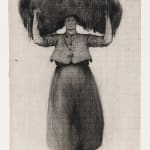Firmin Baes (1874-1943)
Firmin Baes was born into an artistic family of framers, decorators, and architects in Brussels.[1] His father Henri Baes (1850-1920) was a decorative painter and teacher at the Brussels Academy, where Firmin studied from 1888 to 1894. Afterwards, he joined La Patte de Dindon, named after the artist’s pub at the Grand Place in Brussels, where he studied with Eugène Laermans and Emile Fabry. While working with his father’s team on large decoration assignments for restaurants and hotels, Firmin met Léon Frédéric (1856-1940), an occasional collaborator, who influenced his artistic development greatly. In 1900, Baes won a bronze medal at the Exposition Universelle in Paris, granting him international recognition. At the 1904 World’s Fair in St. Louis, he again received the bronze medal. A member of the Belgian artist’s association Pour l’Art from 1908 onwards, Baes exhibited in their salons almost every year throughout his career. Baes joined the Société Royale des Beaux-Arts in 1919, an organization promoting realism and supportive of the Belgian avant-garde.
Baes’s large home and studio in Brussels, where he received visitors and patrons, was filled with his art collection. He worked on a rigid schedule: mornings were for portrait sittings and nude modelling, while afternoons were devoted to still lifes, interiors and landscapes. Baes specialized in highly finished pastels on canvas or large paper supports with striking verisimilitude and coloration. In order to adhere the chalky pastel to the canvas support, the artist developed a novel technique.
Baes was a very prolific artist, recording over 1,300 works in his inventory books. Several portraits and landscapes were executed in the Condroz region in the Belgian Ardennes where Baes must have worked over a period of time. The present drawing is a preliminary study for the slightly smaller painting Porteuses de trèfle or The Clover Carier in the Royal Museums of Fine Arts in Brussels.[2] Two undated paintings with multiple clover carriers in the Brussels Museums are executed in oil and pastel on canvas.[3] Two much larger preliminary studies in Brussels, one also with transfer lines, are dated September 1897, indicating that the subject matter was revisited by the artist over a period of time.[4]
[1] Chantal Lemal-Mengeot, “Firmin Baes”, in: Nouvelle Biographie Nationale, Brussels 2001, Vol. 6, pp. 17-18
[2] Porteuse de trèfle, 1900, oil on canvas, 28.4 x 21.8 cm., Royal Museums of Fine Arts, Brussels, inv.no. 10998/36 https://fine-arts-museum.be/fr/la-collection/firmin-baes-porteuse-de-trefle?artist=baes-firmin-1. All works were donated by Georgette Naegels-Delfosse, Baes’s granddaughter.
[3] Porteuse de trèfle, oil and pastel on canvas, 42 x 52 cm., Royal Museums of Fine Arts, Brussels, inv.no. 10999/51 https://fine-arts-museum.be/fr/la-collection/firmin-baes-porteuses-de-trefle & Porteuses et ramasseuses de trèfle, oil and pastel on canvas, 33 x 49.7 cm., Royal Museums of Fine Arts, Brussels, inv.no. 10999/52 https://fine-arts-museum.be/fr/la-collection/firmin-baes-porteuses-et-ramasseuses-de-trefle?artist=baes-firmin-1
[4] Study for “Les Porteuses de trèfles”, September 1897, charcoal on paper, 59.1 x 28 cm., Royal Museums of Fine Arts, Brussels, object.no. 20003012 https://balat.kikirpa.be/photo.php?path=N014430&objnr=20003012&nr=1 and Study for “Les Porteuses de trèfles”, September 1897, charcoal on paper, 72.3 x 45.6 cm., Royal Museums of Fine Arts, Brussels, object.no. 20003013 https://balat.kikirpa.be/photo.php?path=N014431&objnr=20003013&nr=2
Provenance
Private collection, BelgiumLancz Gallery, Brussels, Belgium, 2022
Literature
Georgette Naegels-Delfosse, Firmin Baes, Brussels 1987, p. 19 ill.



